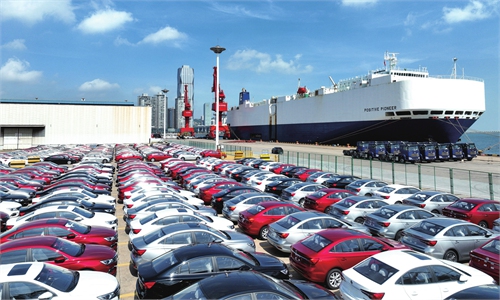Campaigns under way to promote rural sales of electric cars, home appliances, and more

New-energy vehicles are on display on Shanghai Qibao Vanke Plaza on July 30, 2023. Photo: cnsphoto
East China's Shandong Province announced on Tuesday that the provincial government will organize 50 new-energy vehicle and recharge related promotion activities, joining a couple of other provinces to unleash consumption potential in rural areas for stabilizing economic growth.
The local government will also carry out online promotional activities, while stepping up promotion of NEVs targeting farmers at important exhibitions such as Qingdao International Industrial Expo, local media Dazhong Daily reported.
In addition to Shandong, other provinces such as East China's Zhejiang Province have also come up with a raft of policies to encourage rural residents to buy NEVs. According to a circular by Zhejiang government, the province plans to develop a "Zhejiang mode" in boosting the purchase and use of NEVs in rural areas and plans to build a total of 2.3 million charging stations by 2025, of which above 900,000 will be placed in the countryside.
The move comes as the National Development and Reform Commission, the country's top economic planner, released a series of measures to boost consumption by promoting rural spending.
Efforts will be made to encourage rural residents to buy green home appliances and NEVS, while e-commerce and logistics system in rural areas will be improved, and rural leisure tourism will also be developed to ramp up consumption by increasing rural residents' income.
Reviving rural consumption
"The NEV penetration rate in rural areas is far lower than cities, and there is a great potential for the development of NEVs there," Cui Dongshu, secretary general of China Passenger Car Association, told the Global Times.
It's a crucial market opportunity for boosting consumption and widespread use of NEVs in counties and townships where transport conditions remain underdeveloped, so it is of significance to improve the country's consumption structure, Cui said.
This is not the first time that the central government has highlighted rural consumption, he said, noting that the rural market is still an important part of the Chinese economy, and maintaining stable rural spending is of great importance.
Boosted by national strategies like rural vitalization and common prosperity, rural spending has maintained a relatively fast growth in the past years.
Since 2013, China's rural consumer market has grown faster than the urban market. The retail sales in counties and townships posted an annual average growth rate of 10 percent, approximately 2 percentage points higher than the urban areas. The scale of rural consumption market reached 16.8 trillion yuan ($2.35 trillion) in 2022, up from 7 trillion yuan in 2013.
In the first half of 2023, retail sales of consumer goods in rural areas increased by 8.4 percent year-on-year, 0.3 percentage points higher than urban areas, according to data released by the National Bureau of Statistics.
"Rural residents are offering venues for tourism, which will drive up urban residents' tourism demand and other consumption needs," Sun Wenhua, director of the China Agriculture Industry Chamber of Commerce at All-China Federation of Industry and Commerce, told the Global Times.
The abundant natural resources in rural areas and local specialties also need to be explored and integrated for making new consumption scenarios and promote the development of rural economy, Sun said.
Untapped village potential
In order to release this untapped potential among broad villages, more effort is needed in addressing urgent problems that hinder the growth and upgrade of rural spending, for example, measures to increase rural income, improve consumption environment in rural areas and reshape their consumption concept, according to Sun.
In order to make rural residents to spend more, the authorities will smooth the sales channel of agricultural products, develop rural industries with distinctive characteristics and strengthen vocational training for the migrant workers, Zeng Yande, an official with the Ministry of Agriculture and Rural Affairs, said at a press conference on July 22.
Li Qing, a 29-year-old resident in Fengjie, Southwest China's Chongqing city, is a prominent example of young people in cities now moving back to the countryside to start their own businesses.
"Currently, many agricultural industries in rural areas develop fast, but they need more convenient channels to sell their products. It's a business opportunity for me and a better chance to help farmers earn more," she told the Global Times.
She opened a store on '832 Platform', an online sales platform for agricultural and adjacent products in poverty alleviation areas, and selling agricultural products including mushrooms, potatoes, rice and edible oil. "Over the past three years, our total sales volume has exceeded 100 million yuan, driving up income growth for more than 1,000 rural households," Li said.
During the recent years, the rapid development of e-commerce in villages helped bridge the "first mile" for the sale of agricultural products and the "last mile" for purchasing industrial products. Public data showed that by the end of 2022, internet penetration stood at 61.9 percent in rural areas in China and the number of netizens in the countryside reached 308 million, accounting for 29 percent of the country's total online population.
In order to improve rural spending power, more efforts are needed to optimize the logistics system in rural regions and crack down on false advertising and counterfeit goods so as to protect rural consumers' rights and interests, analysts said.
In addition, the social security system in rural areas also needs improvement which will help villagers to save less in banks and spend more, they said.

